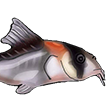| Scientific Name | Hoplisoma trilineatum (Cope, 1872) |
| Common Names | Three Line Cory Leopard Cory, Panzerwels (Germany), Three Stripe Cory, Trestribet Pansermalle (Denmark) |
| Type Locality | Tributary of Río Ambyiacu, Peru. |
| Synonym(s) | Corydoras dubius, Corydoras episcopi, Corydoras trilineatus |
| Pronunciation | hop lee so mah - try lin knee ah tuss |
| Etymology | From the Latin Tres meaning three and lineatus meaning 'of a line'. Alludes to the two pale and single black line running along the fishes body. |
| Articles | |
| Size | 61mm or 2.4" SL. Find near, nearer or same sized spp. |
| Identification | Probably the most misidentified fish commonly found in aquatic retailers who incorrectly sell it as C. julii. The true C. julii is such a rare import that sheer numbers mean you are unlikely to really encounter this Brazilian fish. C. julii is similar to the more spotted forms of C. trilineatus but has no trace of any reticulated colour patterning at all and is entirely covered with small, distinct spots. It's mid-lateral black stripe is fainter and does not reach as far towards the fishes head as in C. trilineatus. This species was described in 1872 with a couple of paragraphs of text and drawings which do not clearly show coloration. The author notes, "Light straw-colored, brownish above, a yellowish lateral band with rather faint brown margin above and below, and blackish median line. A very black spot on the ends of the soft dorsal rays; tail deeply forked, with five vertical bands; anal spotted. Some longitudinal lines on the side of the face". |
| Sexing | Females grow larger and are more full-bodied, this is best observed from above the fish. Males will typically have more pointed as opposed to more rounded fin tips as they mature. |
| Distribution | South America: Central Amazon River basin; Peruvian Amazon and coastal drainages of Suriname. Amazon, Upper Amazon, Marañón, Ucayali (click on these areas to find other species found there) Amazon, Upper Amazon, Ampiyacu (click on these areas to find other species found there) Amazon, Upper Amazon, Marañón, Pastaza (click on these areas to find other species found there) Amazon, Middle Amazon (Solimoes), Purus, Macapá (click on these areas to find other species found there) Login to view the map. |
| IUCN Red List Category | Not Evaluated |
| pH | 5.8 - 7.2 |
| Temperature | 16.0-25.0°C or 60.8-77°F (Show species within this range) |
| Other Parameters | A hardy species that will tolerate most water conditions found within a reasonably maintained aquarium. |
| Feeding | Sinking pellets and frozen bloodworm are ideal although all prepared foods that reach the bottom are accepted. User data. |
| Furniture | Sandy or small rounded gravel is required to ensure the fishes barbels are not damaged in the search for food. Some plants should be used to provide shade and a sense of security. |
| Compatibility | This commonly encountered Corydoras is a perfect community tank citizen. |
| Suggested Tankmates | Should be kept in a shoal of at least six individuals. This, along with the presence of some mid water shoaling species, will increase the confidence of the fish in a community tank environment. |
| Breeding | The fish appears to prefer clean, soft water and should be conditioned in such an environment. pH and temperature seem less important but a drop in temperature may induce spawning. The eggs hatch after four to five days. The eggs are very susceptible to fungus and best removed, treated and the fry allow to hatch in a very controlled environment. The young can be raised on newly hatched brineshrimp again vigilance in respect of water quality is paramount. |
| Breeding Reports | There are 19 breeding reports, read them all here. |
| Reference | Proceedings of the Academy of Natural Sciences of Philadelphia v. 23, pp 281, Pl. 6 (figs. 2a-c). |
| Registered Keepers | There are 357 registered keepers, view all "my cats" data. |
| Wishlists | Love this species? Click the heart to add it to your wish list. There are 4 wishes to keep this species, see who wants what. |
| Spotters | Spotted this species somewhere? Click the binoculars! There are 96 records of this fish being seen, view them all. |
| Forum BBCode | |
| Search for H. trilineatum | |
| Look up H. trilineatum on AquaticRepublic.com | |
 | Look up H. trilineatum on Fishbase |
 | Look up H. trilineatum on Encyclopedia of Life |
 | Look up H. trilineatum on Global Biodiversity Information Facility |
| LFS label creator ARN ref:1.1.1580.508 | |
| Last Update | 2025 Jan 02 01:37 (species record created: 2001 May 04 00:00) |





/siluriformes/callichthyidae/hoplisoma/trilineatum/1.jpg)
/siluriformes/callichthyidae/hoplisoma/trilineatum/2.jpg)
/siluriformes/callichthyidae/hoplisoma/trilineatum/3.jpg)
/siluriformes/callichthyidae/hoplisoma/trilineatum/4.jpg)
/siluriformes/callichthyidae/hoplisoma/trilineatum/5.jpg)
/siluriformes/callichthyidae/hoplisoma/trilineatum/6.jpg)
/siluriformes/callichthyidae/hoplisoma/trilineatum/7.jpg)
/siluriformes/callichthyidae/hoplisoma/trilineatum/8.jpg)
/siluriformes/callichthyidae/hoplisoma/trilineatum/9.jpg)
/siluriformes/callichthyidae/hoplisoma/trilineatum/10.jpg)
/siluriformes/callichthyidae/hoplisoma/trilineatum/11.jpg)
/siluriformes/callichthyidae/hoplisoma/trilineatum/12.jpg)
/siluriformes/callichthyidae/hoplisoma/trilineatum/13.jpg)
/siluriformes/callichthyidae/hoplisoma/trilineatum/14.jpg)
/siluriformes/callichthyidae/hoplisoma/trilineatum/15.jpg)
/siluriformes/callichthyidae/hoplisoma/trilineatum/16.jpg)
/siluriformes/callichthyidae/hoplisoma/trilineatum/17.jpg)
/siluriformes/callichthyidae/hoplisoma/trilineatum/18.jpg)
/siluriformes/callichthyidae/hoplisoma/trilineatum/19.jpg)
/siluriformes/callichthyidae/hoplisoma/trilineatum/20.jpg)
/siluriformes/callichthyidae/hoplisoma/trilineatum/21.jpg)
/siluriformes/callichthyidae/hoplisoma/trilineatum/22.jpg)
/siluriformes/callichthyidae/hoplisoma/trilineatum/23.jpg)
/siluriformes/callichthyidae/hoplisoma/trilineatum/24.jpg)